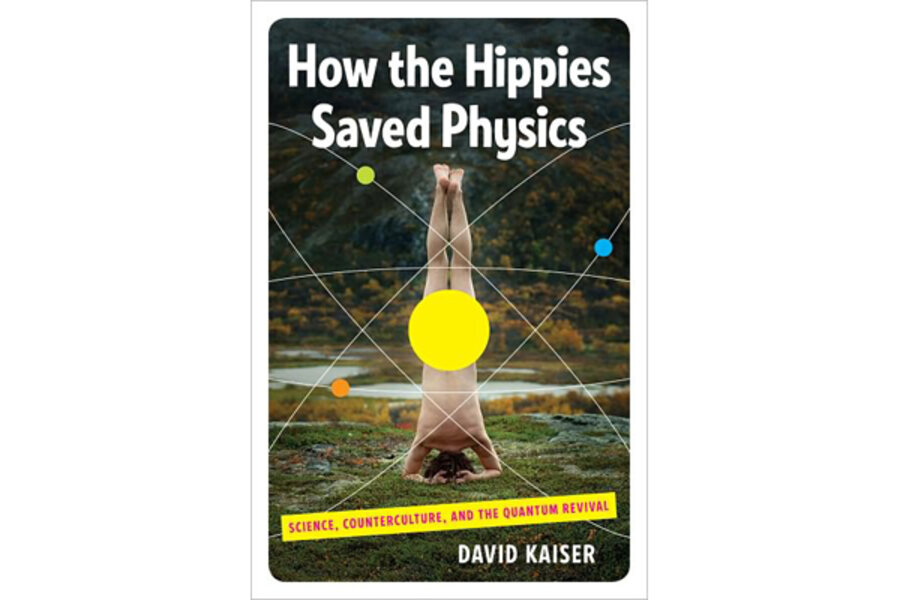How the Hippies Saved Physics, by David Kaiser
Loading...
From the days of Albert Einstein’s nonconformist youth forward, we’ve come to understand that the brilliant minds wrestling with quantum mechanics are pretty far out there compared with the rest of us. Frankly, many physicists seem to delight in their public personas as outlying oddballs who dwell in the spacey clouds of other worlds. But the notion that modern theoretical physics owes its survival, in part, to the counterculture movement of the 1960s and ’70s? Really?
David Kaiser’s new book, How the Hippies Saved Physics, paints a carnival atmosphere of psychedelic imagery. Kaiser writes of a generation of physicists – latter-day disciples of Einstein, Niels Bohr, Erwin Schrodinger, and others postulating the significance of black holes, time travel, and the concept of entanglement – who did their best work while mixing it up with tripped-out contemporaries of Timothy Leary, Allen Ginsberg, and Ken Kesey.
Picture the Young Turks of theoretical physics, who laid the groundwork for today’s concepts like string theory and nanotechnology, contemplating the most arcane of mathematical equations even while holding forth on ESP and UFOs. Picture scuzzy geniuses and rebels with high IQs behaving like ski bums, yet rubbing shoulders with adoring, Nobel Prize-winning elders.
Yes, it actually happened. Kaiser’s narrative takes shape along a curving line of events extending from the Massachusetts Institute of Technology to the Lawrence Berkeley National Laboratory. It also reveals how and why – for a time – many of America’s math whizzes were recruited by the likes of the CIA to work on encryption, the space race, and national defense during the cold war.
For Kaiser, the people that give this book its centrifugal force are eccentric members of the Fundamental Fysiks Group based for the most part in San Francisco. Among them were Fritjof Capra, author of 1975 classic “The Tao of Physics,” along with Gary Zukav (“The Dancing Wu Li Masters”), Jack Sarfatti, (“Space-Time and Beyond”), and Nick Herbert (“Quantum Reality”).
Even as some of them sought to unlock the limitations of their minds with LSD and Eastern mysticism, they plunged headlong into such things as the paradox of Bell’s theorem, which basically suggests that in order to understand the real picture of the universe one needs to accept that we know far less (not more) than we can see or understand.
It is the ultimate license for thinking outside the box of what is perceived to be reality.
The title of the book pertains to a crucial period during the late 1970s and ’80s when demand for physicists by the government and the private sector radically declined, yet the salonlike atmosphere started during the Fysiks era kept quantum physics alive and moving forward.
“The young hippie physicists of the Fundamental Fysiks Group had to blaze a new trail themselves,” Kaiser writes, “carving out their own patrons, forums, and communication outlets during the lean years of the 1970s. Just as their group was winding down, the fortunes of the physics profession began to rebound.”
While many books about physics, even popular ones, tend to suffer from too much headiness, Kaiser, an associate professor at MIT, does an admirable job of making the very concepts of quantum mechanics palpable. What Kaiser’s storytelling does best is make a case for the value of freewheeling free thinking, particularly now, when institutions of higher learning are under siege.
Another sobering point made at the end of the book is that brilliant minds do not sit idle. They can be harnessed as forces for good or, as Kaiser points out, their gifts can be squandered.
After the cold war ended in the early 1990s, some of the physicists and mathematicians that used to contemplate the elemental forces of the cosmos were recruited by Wall Street financial firms and asked to apply their thinking to creating a new investment vehicle. Its name: the derivative, the misuse of which helped to nearly bring down the US economy in 2008.
Todd Wilkinson is a freelance writer in Bozeman, Mont.






